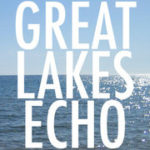
By Eric Freedman
Coverage of the environment in the Great Lakes region involves a lot of reporting on nasty stuff—hazardous waste, invasive species, climate change, air pollution and so on. It involves reporting on good stuff—forests, wildlife, waterways, public lands, outdoor recreation, eco-tourism and the like. It involves covering science and social science studies, legislation, public policy and litigation.
At the Knight Center, we’ve also been pushing our students to report more on the relationships among environment, culture and traditions in the Great Lakes region.
Readers of Great Lakes Echo, our award-winning environmental news service, have always responded well to our stories about shipwrecks and lighthouses, both of them environmental icons of the Great Lakes.
But we’ve also been pushing environmental journalism students – those in our classes and those we hire to work at the Knight Center – to pay more attention to other cultural aspects of the region – the humanities and arts of the region.
If you already follow Great Lakes Echo – and those of you who don’t should sign up for our free daily email story alerts – you may have noticed these kinds of stories in the past year:
- Interviews with the writers of new books with environmental themes – the literature of the Great Lakes – including a poet from Pennsylvania’s Appalachian Front, an essayist from Wayne State University, a memoir writer from Minnesota and a maritime historian from Loyola University in Chicago.
- History, such as the removal of sites from the National Register of Historic Places.
- Native American culture, including the overlap between Indigenous and scientific knowledge of the environment.
- Foodways of the region, with interviews of writers of cookbooks about Indigenous foods and Northern Michigan cuisine.
- Environmental art, such as an online exhibition.
We intend to continue this type of reporting because, as journalists, we believe such cultural aspects of the Great Lakes region help build public awareness of the interconnections between the region’s natural resources and their own lives, the social values of where we live and of the people who share this part of the globe with us.
Eric Freedman is the director of the Knight Center for Environmental Journalism.
